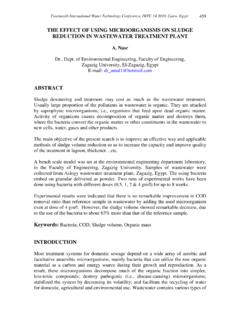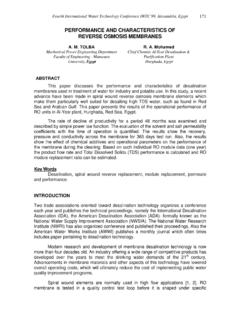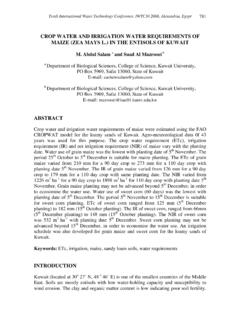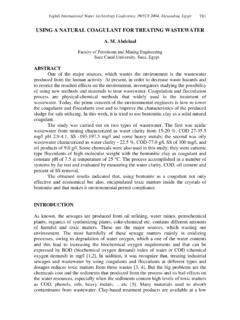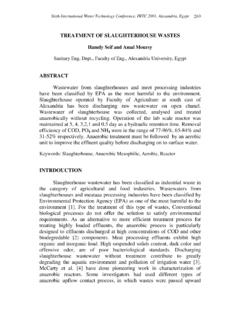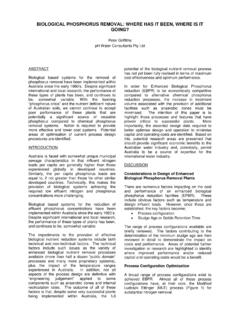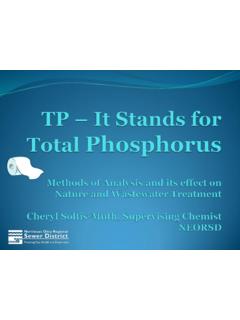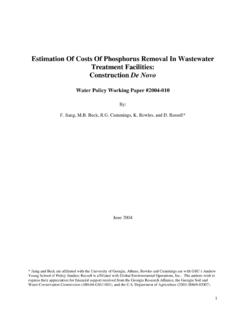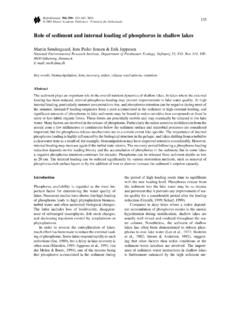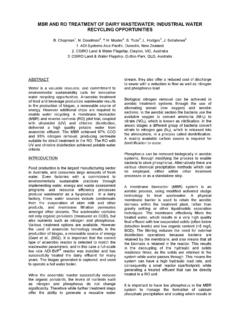Transcription of REMOVAL OF AMMONIA AND PHENOL FROM …
1 Eleventh International water Technology Conference, IWTC11 2007 Sharm El-Sheikh, Egypt 949 REMOVAL OF AMMONIA AND PHENOL FROM industrial waste water Alaa Eldean Kabbarry Ramadan Master of Occupational Health Assistant General Manager of Environmental Sector, Middle East Operation & Maintenance Co. (MIDOM), Egypt E-mail: ABSTRACT The activated sludge process is a wastewater treatment method in which the carbonaceous organic matter of wastewater provides an energy source for the microorganisms. The microbes convert carbon into cell tissue and oxidized end products that include production of new cells for a mixed population of microorganisms in an aquatic aerobic environment carbon dioxide and water . In addition, a limited number of microorganisms may exist in activated sludge that obtains energy by oxidizing AMMONIA nitrogen to nitrate nitrogen in the process known as nitrification.
2 The beneficial role of nitrifying bacteria within saltwater and freshwater aquaria environments is their function in the nitrogen cycle, which involves the conversion of AMMONIA to nitrite and the subsequent conversion of nitrite to nitrate .During the process of nitrification, nitrifying bacteria detoxify AMMONIA in two steps. First, Nitrosamines spp. converts toxic AMMONIA to nitrite, which is also toxic to fish. Then in the second step, nitrite is converted to nitrate by the Nitrobacter spp. Nitrate is not considered toxic unless it accumulates in high concentrations. There are numerous commercial products claiming to contain nitrifying bacteria that will facilitate the conversion of toxic AMMONIA to non-toxic nitrate within aquaria. In this paper we discussed the factors affecting on the growth of nitrifying bacteria and the best conditions to reduce (over 85% of AMMONIA , over 90% of PHENOL and over 80% of BOD) in biological step in waste water treatment plant for industrial waste water .
3 INTRODUCTION The beneficial role of nitrifying bacteria within saltwater and freshwater aquaria environments is their function in the nitrogen cycle, which involves the conversion of AMMONIA to nitrite and the subsequent conversion of nitrite to nitrate. During the process of nitrification, nitrifying bacteria detoxify AMMONIA in two steps. First, Eleventh International water Technology Conference, IWTC11 2007 Sharm El-Sheikh, Egypt 950 Nitrosomonas spp. converts toxic AMMONIA to nitrite. Then in the second step, nitrite is converted to nitrate by the Nitrobacter spp. Nitrate is not considered toxic unless it accumulates in high concentrations. There are numerous commercial products claiming to contain nitrifying bacteria that will facilitate the conversion of toxic AMMONIA to non-toxic nitrate within aquaria. This study was undertaken to investigate the efficacy of both nitrification and de-nitrification Efficacy was determined by measuring the conversion of AMMONIA and nitrate for nitrification and by measuring the reduction of BOD and PHENOL for de-nitrification.
4 Studies in our laboratory have indicated that the factors affecting on nitrification and de-nitrification processes. BIOLOGICAL TREATMENT The biological treatment consists of two steps nitrification and de-nitrification in the most plants the first step is nitrification and the second step is the de-nitrification but in our plant the first step is de-nitrification and the second step is the nitrification. One study demonstrated that a C: N ration of at least 3:1 was necessary after nitrification to promote de-nitrification. At lower C: N ratios, the rate of de-nitrification decreased rapidly. One preferred method to avert the problem of effluent degradation is to place the de-nitrification basin before the aerobic reactor basin (in which carbonaceous REMOVAL and nitrification are taking place) and recycle a high volume of the flow from the nitrification reactor basin back to the de-nitrification basin Raw wastewater also has been used as the source of organic carbon to effect de-nitrification.
5 However, this procedure may adversely affect effluent quality by causing increases in BOD5 and AMMONIA . BIOLOGICAL FLOCCULATION One of the factors essential to the performances of the activated sludge process is effective flocculation of the sludge, with subsequent rapid settling and compaction of the floc, it has been shown that flocculation results from the production of a sticky polysaccharide slime lager to which organism adhere. Flagellates are also entrapped in this slimy material. The slime formation does not occur during the long-growth phase and required excess available carbohydrate. Effective flocculation therefore requires a relatively low food-to microorganism s ratio (declining growth and high sludge age) and excess available carbohydrate. Flocculation it self will not ensure rapid settling. Conditions in the process must be maintained to promote a high-density sludge. Eleventh International water Technology Conference, IWTC11 2007 Sharm El-Sheikh, Egypt 951 In general, the maintenance of aerobic conditions with an available carbon source stimulates the growth of fungi and other filamentous forms, resulting in so-called bulking sludge.
6 Okun indicated that Spherotilus are aerobic and require oxygen and an available carbon source but may suffer in the competition for food in highly aerobic environment. Because of their high surface area/volume ratio, the filamentous organisms may survive better under low oxygen tensions than other flocculated aerobic growth. Failure to maintain oxygen in the aeration system can result in diffuse non settling floes because of the high for production under anaerobic conditions. Maintenance of aerobic conditions in the aeration tank, followed by an anaerobic period in the final clarifier, appears to promote growth of facultative bacteria which are effective in the REMOVAL of BOD and produce high-density flocs and to limit the growth of filamentous organisms. NUTRIENT REQUIREMENTS In all biological waste treatment systems it is necessary for microorganism to have all the necessary elements to build protoplasm.
7 The nutritional requirements of microorganism fall into four categories: Compounds that furnish carbon and nitrogen. Compounds that serve as a sources of energy. Inorganic ions. Trace substances. All natural organic substances, some inorganic, and many synthetic ones are attached by at least one species of microorganism. Some organic substances as their primary food source while others are more specific. All microorganisms require the basic elements: carbon, nitrogen, phosphorus, and sulfur together With certain trace elements such as: Potassium, calcium, zinc, magnesium, iron, manganese, copper, and cobalt. Carbon, nitrogen, and phosphorus generally are required in balanced amounts. Most of the compounds entering into the growth of active biomasses are normally available in the treatment plant influent. As a result domestic wastewater generally provides a nutritionally balanced food source for bacterial activity.
8 However, the presence of a large proportion of certain industrial wastes, devoid in nitrogen or phosphorus, may upset this balance. In such cases nutrient addition may be necessary. One of the most important aspects of nutritionally deficient wastes is their effect on biological predomination. A partially deficient nitrogen or phosphorus waste will stimulate fungal rather than bacterial growth since the fungi build protoplasm with Eleventh International water Technology Conference, IWTC11 2007 Sharm El-Sheikh, Egypt 952 lower nitrogen and phosphorus contents. The fungi that predominate are filamentous and may cause bulking of activated sludge in secondary sedimentation tanks. When insufficient nitrogen is present, the amount of cellular material synthesized per unit of organic matter removed increases as an accumulation of polysaccharide. At some point nitrogen limiting conditions restrict the rate of BOD REMOVAL .
9 Not all organic nitrogen compounds are available for synthetics. AMMONIA is the most readily available form , and other nitrogen compounds must be converted to AMMONIA . Nitrite, nitrate and about 75% of organic nitrogen compounds are also available. How much nitrogen and phosphorus are required to promote active biomass generation? A chemical analysis of a mixed aerobic bacterial population in biological waste treatment gave an approximate composition of cell tissue as On this basis, and % by weight of nitrogen and phosphorus, respectively, would be required to promote bacterial cell development. The weight of each element required per day then would be determined by multiplying these percentage factors by the weight of organisms produced per day. The more conservative approach for estimating nitrogen and phosphorus requirements in biological treatment systems relates the influent BOD5 to the quantity of these elements required as 20:1 for BOD5: N and 100:1 for BOD5: P.
10 These ratios can be used on either a mass or concentration basis. Sources of nitrogen Bacteria derive their source of elemental nitrogen by assimilating AMMONIA , but also have the ability to use nitrites and nitrates as well as gaseous nitrogen under certain circumstances. Most facultative bacteria of importance in activated sludge systems have the ability to reduce nitrates to nitrites and, through a series of intermediates, to AMMONIA for incorporation into protoplasm. This assimilative reduction of nitrates and nitrites is specific for meeting their protoplasmic needs and can occur in the presence of excess oxygen but will not occur as long as there is an excess of AMMONIA . Bacteria derive their source of elemental nitrogen by assimilating urea. Sources of phosphorous Bacteria derive their source of elemental phosphorus by assimilating soluble orthophosphate (PO4)-8.
